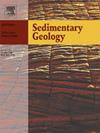现代热带珊瑚礁和碳酸盐台地沉积物分布和相重新审视:全球视角
IF 2.9
2区 地球科学
Q1 GEOLOGY
引用次数: 0
摘要
在大西洋西部、印度洋中部和东部、太平洋南部和西部以及波斯湾的热带珊瑚礁和碳酸盐台地上收集的地表沉积物样本(n = 886)已被重新审视和全面检查。样品来自礁前、礁缘、砂围裙、浅礁湖、深礁湖、限制礁湖、斑礁、岛屿、近岸等12种沉积环境;内坡道,中坡道,外坡道。用定量和统计的方法对颗粒组成、结构、矿物学和地球化学进行了分析。珊瑚骨骼碎片、钙质藻类(红珊瑚藻,haalimeda)、软体动物壳和非骨骼颗粒(主要是似球粒)是最丰富的碳酸盐颗粒成分。珊瑚和颗粒支撑的结构在边缘很常见,而泥和颗粒支撑的结构与软体动物、海门动物和非骨骼颗粒在边缘平台内部普遍存在。非边缘平台的特点是内坡道上有非骨骼颗粒,而中、外坡道上有丰富的软体动物壳。利用多元成分和结构统计数据,识别出14种相,包括:(1)富石英泥灰岩,(2)石英砂,(3)有孔虫颗粒岩-包岩,(4)软体动物-有孔虫颗粒岩-包岩,(5)软体动物颗粒岩-包岩,(6)非骨骼颗粒岩-包岩,(7)海蜇类颗粒岩-包岩,(8)富珊瑚颗粒岩,(9)富石英生物源颗粒岩,(10)软体动物包岩,(11)珊瑚包岩,(12)非骨架包岩到微晶岩,(13)微晶岩,(14)泥岩。细粒(“泥”)的数量与水深(即沉积能量)之间存在统计学上显著的相关性,然而,单个相表现出较大的深度范围,从而强调了先前的研究,这些研究挑战了直观和长期存在的沉积物分布概念。该方案的一个例外是波斯-阿拉伯海湾北部的斜坡系统,其相边界大致遵循水深等高线。文石(相对丰度83.2±0.6%±平均标准误差)和高镁方解石(11.1±0.6%)是最常见的碳酸盐相,反映了生产商的骨骼矿物学特征。低镁方解石丰度最低(5.2±0.1%)。大块样品的氧稳定同位素(δ18O:−3‰~ +3‰)和碳稳定同位素(δ13C:−2‰~ +6‰)变化范围广,主要受区域控制,而不受礁体和碳酸盐岩台地沉积环境的控制。西大西洋和南太平洋台地样品的δ13C最高,这是由于存在大量的非骨架颗粒,而印度洋开阔样品缺乏这些颗粒。波斯湾和鲨鱼湾的样品δ18O最高,这是由于表层海水盐度升高所致。与印度-太平洋台地沉积物相比,西大西洋(环流受限的台地内部)底部沉积物中大量的halmeda血小板似乎更为丰富。有证据表明,在碳酸盐过饱和度高、骨性生产和沉积速率低的地区,非骨性颗粒优先存在;在西大西洋、波斯湾、沙克湾和南太平洋的某些地区,这些先决条件都得到了满足。泥浆的起源仍有争议,但从现代全球的角度来看,生物成因(碎屑)的起源似乎比非生物成因的起源更占优势。本文章由计算机程序翻译,如有差异,请以英文原文为准。
Sediment distribution and facies of modern tropical reefs and carbonate platforms revisited: A global perspective
Surface sediment samples (n = 886) collected on tropical reefs and carbonate platforms in the western Atlantic, the central and eastern Indian Ocean, the south and west Pacific Ocean, and the Persian Gulf have been revisited and examined in their entirety. The samples stem from twelve depositional environments, i.e., fore reef, reef margin, sand apron, shallow lagoon, deep lagoon, restricted lagoon, patch reef, island, nearshore; inner ramp, mid ramp, and outer ramp. Grain composition, texture, mineralogy, and geochemistry have been analyzed in a quantitative and statistical manner. Fragments of coral skeletons, calcareous algae (red coralline algae, Halimeda), mollusk shells, and non-skeletal grains (predominantly peloids) are the most abundant constituent carbonate grains. Coralgal, grain-supported textures are common at the margins whereas mud- and grain-supported textures with mollusks, Halimeda, and non-skeletal grains are ubiquitous in rimmed platform interiors. Non-rimmed platforms are characterized by non-skeletal grains on the inner ramp, while mid and outer ramps are rich in mollusk shells. Multivariate statistics of composition and texture data have been used to discern fourteen facies including (1) quartz-rich marl, (2) quartz sand, (3) foraminiferal grainstone to packstone, (4) mollusk-foraminiferal grainstone to packstone, (5) mollusk grainstone to packstone, (6) non-skeletal grainstone to packstone, (7) Halimeda grainstone to packstone, (8) coral-rich grainstone, (9) quartz-rich biogenic grainstone, (10) mollusk packstone, (11) coral packstone, (12) non-skeletal packstone to wackestone, (13) wackestone, and (14) mudstone. There is a statistically significant correlation between the amount of fines (‘mud’) and water depth, i.e., depositional energy, however, individual facies exhibit large depth ranges, thereby underlining previous studies that have challenged intuitive and long-standing concepts of sediment distribution. An exception to this scheme is the ramp system in the northern Persian-Arabian Gulf where facies boundaries approximately follow bathymetric contours. Aragonite (83.2 ± 0.6 % relative abundance ± standard error of mean) and high-magnesium calcite (11.1 ± 0.6 %) are the most common carbonate phases reflecting skeletal mineralogy of producers. The abundance of low-magnesium calcite is lowest (5.2 ± 0.1 %). Stable isotopes of oxygen (δ18O: −3 ‰ to +3 ‰) and carbon (δ13C: −2 ‰ to +6 ‰) of bulk samples exhibit wide ranges and appear to be controlled principally by region rather than by depositional environment within reefs and carbonate platforms. Western Atlantic and south Pacific platform samples show the highest δ13C, as a consequence of the occurrence of abundant non-skeletal grains, which are largely lacking in the open Indian Ocean samples. Samples from the Persian Gulf and Shark Bay reach the highest δ18O due to elevated salinity in surface waters. High amounts of Halimeda platelets in bottom sediments appear to be more abundant in the western Atlantic (platform interiors with restricted circulation) as compared to Indo-Pacific platform sediments. There is evidence that non-skeletal grains are found preferentially where carbonate supersaturation is high and skeletal production and sedimentation rates are low; these preconditions are fulfilled in the western Atlantic, the Persian-Arabian Gulf, Shark Bay, and in certain areas of the south Pacific. The origin of mud is still controversially discussed, but from a modern global perspective it appears that biogenic (detrital) origins predominate over abiogenic origins.
求助全文
通过发布文献求助,成功后即可免费获取论文全文。
去求助
来源期刊

Sedimentary Geology
地学-地质学
CiteScore
5.10
自引率
7.10%
发文量
133
审稿时长
32 days
期刊介绍:
Sedimentary Geology is a journal that rapidly publishes high quality, original research and review papers that cover all aspects of sediments and sedimentary rocks at all spatial and temporal scales. Submitted papers must make a significant contribution to the field of study and must place the research in a broad context, so that it is of interest to the diverse, international readership of the journal. Papers that are largely descriptive in nature, of limited scope or local geographical significance, or based on limited data will not be considered for publication.
 求助内容:
求助内容: 应助结果提醒方式:
应助结果提醒方式:


